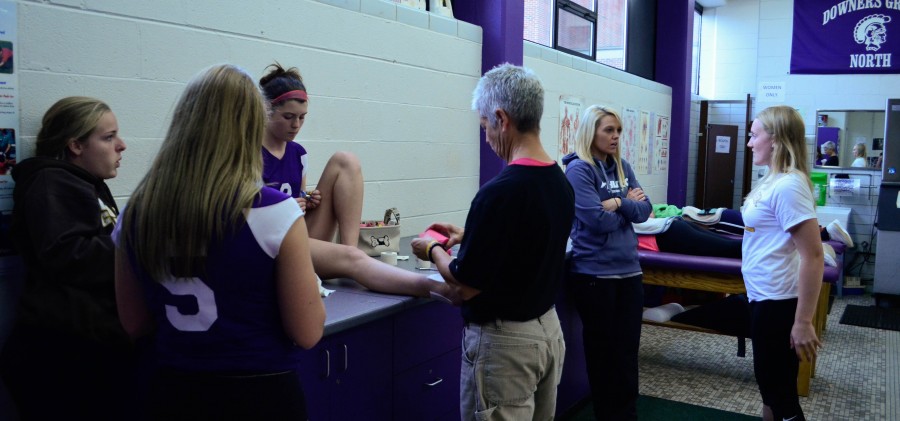Mia Chudzik| Feature Editor
[email protected]
Jill Ferree and Krystal Stawychey are the masters behind the curtain. Everyday they fill up water coolers, tape up injured limbs, and take care of athletes in times of need. But between the two of them, they can only help so many people at a time.
The athletic trainers have one job: to take care of the athletes. That includes taping, rehab/physical therapy, injury prevention, and getting athletes ready for practice.
One rumor students hear is that the athletic trainers have a bias towards football players over other athletes. After investigation, this rumor has been proven to be false.
When dealing with an average of 30 to 40 kids a day, things can get a bit chaotic, so there is some order needed. Athletes that are getting on buses for away games have first priority for being helped, then athletes who need tape for practice, then those waiting for an evaluation. No specific team has priority over another.
“Varsity football players have 8th period off, so they tend to get here earlier than everybody else. They get more attention since they can sometimes be the only ones in the room, not because they are favored. If they get here at the same time as other athletes, they wait in line with them,” Stawychey said.
However, football players aren’t the only ones with 8th period off. With the coaches discretion, other athletic teams can be released after 7th, giving them more time in the training room.
“In addition to football players coming into the athletic training room 8th period we’ve also had boys soccer, off-season girls basketball and Athena dancers just to name a few of the other athletes we see period 8. It’s not just football players,” Ferree said.
Ferree can explain why things may seem biased. “It may seem as if we’re biased towards the football team, but people need to realize that because of the number of athletes participating on two freshman teams, one sophomore team, and one varsity team, the football program totally outnumbers the size of the other fall teams currently competing,” Ferree said. “Because football is considered a ‘high-risk’ injury and contact sport, we’re naturally going to see football players possibly more than others. It’s inevitable.”
Another rumor thrown around is some athletes claim they don’t get as much medical equipment as other athletes. “The amount of equipment a team uses doesn’t matter,” Stawychey said. “Whether the volleyball team uses 100 rolls of tape or five, every team gets what they need. There’s a budget for how much equipment we can buy, but not for how much equipment a team can use.”
Varsity football member and senior Kendrick Schultz doesn’t seem to think they get treated better. “I can see why people might think that,” Schultz said. “We have 8th period off so we get there before a lot of other athletes, but we don’t get special treatment.”
Senior Tessa Rigoni visited the trainer often during last year’s softball season due to an arm injury. “Every time I went to the athletic training room I was helped right away,” Rigoni said. “I’ve never been told to wait when I’m being helped for a baseball player or for anyone else.”
With only two trainers and multiple practices, games, and meets happening per day, it’s hard for them to be everywhere at once.
The athletic trainers are required to attend all home sports events. They also travel with teams to any playoff game and beyond. Some days they get to school at 2:25 p.m. and don’t walk out the doors until 11 p.m.
Trainers are also required to attend all away football games. “We are required to travel to away games for football because of the high risk when it comes to injuries,” Stawychey said. “It’s part of the contract.”
When football isn’t in season, the trainers have more time to attend different events. “There’s always a trainer at our games,” Ben Magro, senior and member of the varsity baseball team said. “Some guys go there [training room] for ice after practice and there’s always someone there. They seem happy with the way it’s run.”
Ferree understands the difficulties that accompany a job like hers, but she acknowledges the rewarding aspects as well. “My job is multi-faceted and every day is different than the previous day. It’s enjoyable because of the athletes we work with and the opportunity to remain involved in athletics. The job is also challenging because of scheduling changes, communication issues and things out of our control such as weather. You definitely have to be flexible and adapt to the situation given you. It’s rewarding to see injured athletes complete rehab programs, return, and be successful in their sports,” Ferree said.


